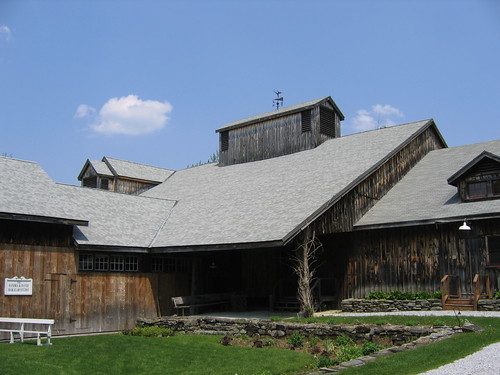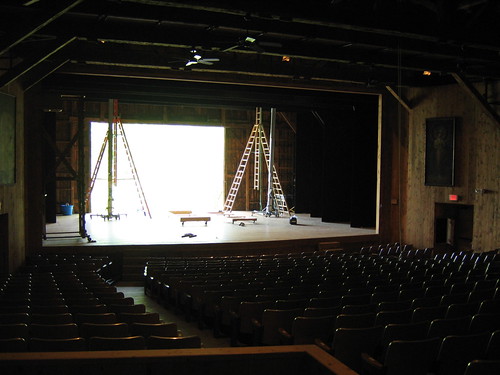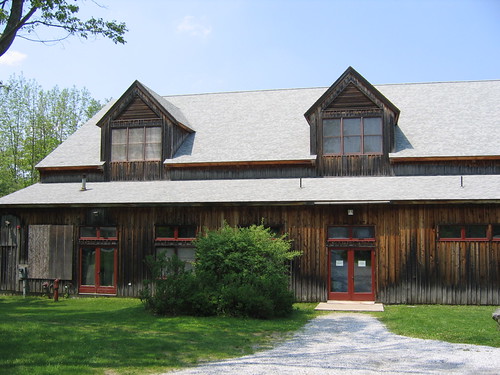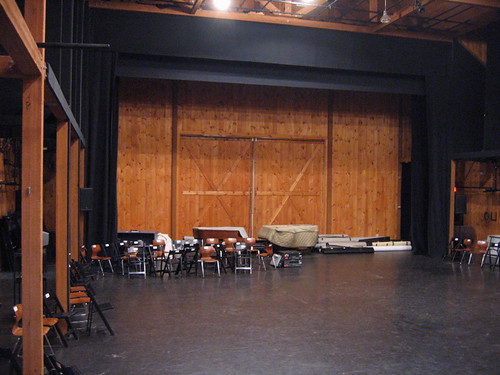Today is history day! We had a lot of history education yesterday, and I want to pass some of that history along to you all, because the significance of this place to dance is huge. I'm going to quote a few dates and figures--they may not all be precisely correct, but they'll be accurate to within five years or a decade or so.
Jacob's Pillow was originally a farm; it was bought by Ted Shawn in the late 1920s, and he used it to start the company of all male dancers which would become known as "Shawn and His Men Dancers." Dancers at that time were almost exclusively female, in the European tradition, and so having a troupe of male dancers was quite a sensation. The dancers were amateurs, many of them athletes from a college where Shawn taught.
The Men Dancers were working together at the worst time in the Great Depression, so they farmed their own food and worked together to erect buildings specifically for dance, including what is now the Bakalar Studio. In order to raise money for the company, they held parties in the Tea Garden, shown below, where the dancers would serve tea. Shawn would give lectures on his choreographic methods, after which the dancers would do a performance. The audience members were usually rich old dowagers, and the mens' costumes were rather scanty, so, according to one of the Men Dancers, it became a rather popular event quite quickly. A photo of the Tea Garden is below.

The Ted Shawn Theatre, shown below, was built in 1930, and it is the Pillow's main performance space. It seats about 650, and over the years, it has seen performances by nearly every major name in dance. It is traditional for performers to sign their names on the walls of the dressing rooms, so you can see names like Merce Cunningham, Alonzo King, and Alvin Ailey on the walls, to name a few (I haven't actually found these names, but I know they've performed here, so I assume they're around). The weathervane on top is modeled after a pose struck by Barton Mumaw, one of the original Men Dancers, in a piece choreographed by Shawn.


For the techies among you, the Shawn, as we call it, has a fly system, but because the roof is shaped like a barn, we don't have any fly space to speak of, so we can't fly out large objects. Also, the rigging system is single purchase hemp rope, which is about as low-tech as you can get with a theatrical rigging system. This means that the people pulling the ropes carry the full weight of whatever is being flown. If what you are flying is 500 pounds of rice, they have to hold up 500 pounds. The rice story is not just a random example; several years ago, a Korean company wanted to drop 2,000 pounds of rice from overhead like snow, and they actually did it.
The reason the Shawn is low-tech is not for lack of money; it's actually deliberate. Not only does the Pillow staff deliberately cultivate a rustic feel, but since the entire campus has been named a National Historic Site, there are actually limitations to how much the existing buildings can be changed. It's kind of an interesting side effect of historical significance--you can't changed anything.
An interesting note about the Shawn is that because it is built entirely of wood, it is apparently a great venue for rhythmic dances such as clogging and tap because audience members can feel the vibrations of the dancers' footfalls in their seats. I say apparently, because I haven't seen any shows in there yet, obviously. There aren't any pure tap or clogging groups on the roster for this summer, but I think some of the companies will be percussive in part, so I hope I'll be able to report on the accuracy of that claim.
The Doris Duke Studio Theatre, shown below, was built in 1990, but as you can see, it closely matches the styling of the Ted Shawn Theatre. This is due to the low-tech atmosphere I mentioned above. Both the inside and the outside have bare wood paneling, and it even has giant barn doors, like the Shawn. However, it has a permanent grid, unlike the Shawn, and air conditioning, also unlike the Shawn. We'll be doing some interesting things in there this season, like flying people. The theatre was originally conceived as a flexible seating space, but apparently no one ever wanted to change the seating layout, so at some point they decided to simply make the seating arrangement permanent.


As a side note, one of the pianos on the stage is apparently an 1850s Steinway Grand. I'm very excited to hear it play.
No comments:
Post a Comment